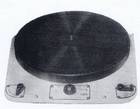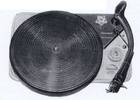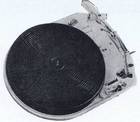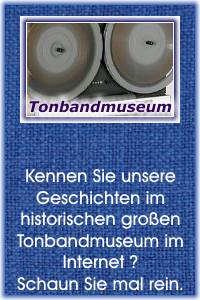Einblick in den Imhofs Hifi Katalog von 1962
Es ist etwas Besonderes, einen so gut erhaltenen Hifi-Katalog aus dem England von 1962 zu bekommen. Wir haben die Seiten so geschickt wie möglich aufgeteilt, sonst würde eine einzelne Seite zu lang werden. Blättern Sie oben in der weißen Leiste von Seite zu Seite.
Der eigentliche 1962er Produktbereich in diesem Prospekt beginnt mit den Programmquellen in Mono und Stereo.
Achten Sie auch mal auf die einzelnen Sätze, bei denen wir Deutschen die ganzen Kommata vermissen. Scheinbar hatte man in England das Trennen eines längeren Satzes dem Leser überlassen.
-
choosing a motor (gemeint ist der Plattenspieler)
It is essential to have a turntable which runs freely, without vibration or fluctuation in speed.
The turntable itself should be fairly heavy and, if possible, accurately machined. The bearings should fit accurately to prevent side play. The motor should be inherently free from vibration and sprung so as to reduce vibration to a minimum. A selector for three or four speeds should be incorporated; on some models there will be an adjustment for all speeds. To set each speed accurately a stroboscope indicator is required.
The pick-up is generally considered separately. Automatic changers are sometimes frowned on for L.P. and stereo records. They are very convenient, though, and one can use an automatic changer which also allows manual changing or separate motors, one with a single-play arm and one with an automatic changer.
The term 'transcription motor' is best regarded as indicating the individual manufacturer's leading model; a study of the specification and performance is the best indication of true quality. We shall always be happy to advise you if you are in doubt. Generally speaking, a good motor costs £15 - £20 and a very good one about £30.
As Imhofs have the largest stock of records in the world, it is possible for you to hear virtually any records you like played on the equipment in which you are interested.
transcription motors 1962 (Auflistung der Plattenspieler)
Hier sieht man bereits, wieviel Auswahl im England 1962 schon vorhanden war, als es bei uns in den wenigen Hifi-Studios nur ganz wenige High-End Laufwerke und Tonarme gab. Auch das Angebot an Abtastsystemen war bei uns denkbar gering.
-
B & O Type 608
Turntable: 8i" die-cast alloy with built-in stroboscope, belt driven for vibrationless operation. Speeds: adjustable on all four speeds. Voltage: 220V 50 cycles. Fitted with ST/L Pick-up and mounted on a Teak base. Dimensions: 14" x 12" x 7".
Garrard 301
Turntable: die-cast aluminium alloy, lathe-turned, in precision bearings. Speeds: adjustable on all three speeds. Voltage: 100-130V. or 200-250V., 50 c/s or 60 c/s. Dimensions: plate 14" x 13" x 2" above and 3" below under-surface. A motor for professional use and for those requiring the highest standard. Available (301)S with stroboscope markings.
Sugden Connoisseur Model B
Turntable: cast non-ferrous metal, lathe-turned, in precision bearings. Speeds: adjustable on all three speeds; synchronous motor. Voltage: 200-250V., 50 c/s; to order, 200-250V 60 c/s or 110V. 50 c/s or 60 c/s. Dimensions: plate 15" x 13" x 3" above and 3" below plate. A motor of professional standard with built-in stroboscope.
Sugden Connoisseur Craftsman
Turntable: 12" cast non-ferrous metal. Speeds: 33y and 45 rpm. Fixed speeds. Synchronous motor. Voltage: 210-250V. 50 c/s; to order: 210-250V. 60 c/s or 110V. 50-60 c/s.
Goldring-Lenco GL70
Turntable: die-cast alloy. Speeds: continuously variable between four speeds. Voltage: 200-250V. Dimensions: 15" x 13" x 5". Pick-up: L70 arm accepts stereo or single-channel cartridges. Lifting and lowering device eliminates handling. The GL 59, without pick-up, is also available.
Goldring Lenco GL 58
Speeds: variable between four speeds. Voltage: 110-250V., 50 c/s. Dimensions: plate 15" x 13" x 3" above motor plate and 2" below. Pick-up: G.60 arm accepts single-channel or stereo cartridges.
single players 1962
-
Garrard TA Mk. II
Voltage: 100-130V. or 200-250V., 50 c/s or 60 c/s. Dimensions: 14" x 12" x 3" above and 2" below top of motor board. A good player at a reasonable price; wired for stereo.
Garrard 4HF
Turntable: heavy gauge pressed steel. Speeds: four, control range ±3% on each. Voltage: 200-250V or 100-130V, 40 c/s, 50 c/s or 60 c/s to order. Dimensions: space required: 17" x 13" x 3" above and 3" below top of motorboard. Pick-up: TPA12, wired for stereo. Also available on B3 base.
Philips AG 1016
Voltage: 110-240V AC 50 cycles. Dimensions: 15" x 12" x 5" above and 3" below motor board. Facilities for automatic changing of 7" records. Fitted with Stereo/Mono pick-up with sapphire styli.
automatic changer 1962
Es war fast genau 1 Jahr vor dem DUAL 1009 vom August 1963, der den gesamten Hifi-Plattenspieler Markt umkrämpelte, auch in England, vor allem aber in den USA. Dort wollte "der Kunde" einen 10fach Wechsler haben, warum auch immer.
-
Garrard Type A
Turntable: sandwich structure with magnetic inner shell and non-magnetic outer. Speeds: four. Voltage: 100-130V and 200-250V, 50 or 60 c/s. Dimensions: requires space 16"x 14"; with 6" above and 2" below top of motor board. A high-grade autochanger of remarkably high standard.
Also available on B6 base as illustrated.
choosing a tuner
To achieve a high standard of reproduction from even the best equipment, the signal from the radio must itself be of high standard. On FM (frequency modulation) transmission, the B.B.C. sets an extremely high standard and for this reason many people use only an FM tuner. However, oversea transmissions are of great interest, even though they are of less high standard, and to receive them an AM (amplitude modulation) tuner is required.
This may be separate from the FM tuner or combined on the one chassis. A good aerial, depending on the location, will improve reception considerably. Near the FM transmitter, a less sensitive tuner will suffice. Some amplifiers provide spare power for tuners but with others a self-powered tuner or a separate power pack is essential.
In FM tuners, a tuning indicator (or 'magic eye') is best for accurate tuning, althounh with automatic frequency control it is not essential. A switched tuner, with preset controls for selecting stations does, of course, simplify matters. A final point which affects the price of a tuner is the finish.
A medium quality FM tuner usually costs £20 - £25 and an AM/FM tuner five or ten pounds more, while for the best of both you would need to pay around £60 to £70. Imhofs world-wide experience enables us to recommend the most suitable tuner for any country.
list of tuners 1962 (und unser Kommentar)
Bemerkenswert ist hier einmal die Menge der uns fast völlig unbekannten Anbieter, und daß die Engländer so großen Wert auf die Anzahl und die Typen der Röhren gelegt hatten.
Ob das den (englischen) Kunden wirklich interessiert hatte ? In Deutschland wurde zu der Zeit gerade die Anzahl der Kreise abgeschafft. So hatte es ja auch nur die Gurus interessiert, wie später zum Beispiel die UKW Empfindlichkeit in MicroVolt.
Über die eigentlich wichtige UKW Qualität wurden selten vernünftige Aussagen gemacht. Auch war UKW-Stereo bei diesen FM-Tunern noch fast unbekannt. Da war Max Grundig 1962 bereits ein Stück weiter.
-
Acoustical AM II European
Valves: EF89, ECH81, EBF89, EM84. Tuning ranges: Long wave band 800-2070 metres. Medium wave band 185-588 metres. Short wave band 5,8-18.5 Metres Dimensions: 10V x 3±" x 6". Weight: 6 \b.
Acoustical A Mil/Overseas (Not Illustrated) Valves: EF89, ECH81, EBF89, EH84. Tuning ranges: Long wave band 800-2070 metres. Short wave band 2.2-6.6 Metres. Short wave band 2. 5.8-18.5 Metres
Acoustical F.M.
Valves: 6BJ6, 12AT7/ECC81, 6BH6 (two), 6AU6.6, AL5/EB91, 12AX7/ECC83, neons Hivac CC11L, lamp 6.5 v. 0.3 A.
Armstrong ST3 Mk. 2 AM/FM
Valves: two ECC85, ECC83, ECH81, EF89, EB91, DM70, OA81. Frequency range: 87-108 Mc/s, 187-570 metres, 1,053-2,000 metres. Power supply: 200-250V, 40-60 cycles. Consumption: 40 watts.
Armstrong T4B
Valves: two ECC85, EF89, EF80, EB91. Frequency range: 87-108 Mc/s. Power supply: 200-250V., 40-60 cycles. Consumption: 26 watts.
Chapman S6BS/FM
Valves: three EF89, ECH81, EM84, EF85, ECF80, two EF80, EB91, EZ80, EBF80. Frequency range: 37-108 Mc/s, 11m, 13m, 16m, 19m, 25m, and 31m in six band spread ranges, 13-43m, 43-140m, 175-570m. Power supply: 110V and 200/250V 50 c/s. Consumption: 65 watts.
Chapman S6BS Tuner Unit
Valves: one B9A, three EF89, one ECH81, one EBF80, one EM81. Wave range: 13m, 16m, 19m, 25m, 31m, and 41m, in six band spread ranges, and 13m-43m, 43m-140m, 175m-570m.
Dynatron FM II LV
Valves: five EF80, EB91, B719. Switched VHF Tuner. Consumption: 26 watts HT 45mA at 250V. Heater: 6.3V, 2.5A.
HMV558 AM/FM
Valves: ECC85, ECH81, EBF89, EF80, EB91, ECC83, EM85. Wavebands: FM 87-108 Mc/s, AM Medium wave 522-1,630 kc/s (190m-525m). Long wave 145-275 Kc/s (1,000m-2,000m). Distortion: less than 0.1%. Hum and noise: 20 db down.
Jason Monitor
Valves: ECC81, ECF80, EF80, two EF89. Switched VHF and TV Sound. Dimensions: 5" x 5±" x 7".
Jason FMT4
Valves: two EF89, EF80, EZ80, ECC85. Frequency range: 88-108 Mc/s. Switched AFC. Power supply: 210-250V 50-60 c/s or 115 V 50-60 c/s to order.
Jason JTV2
Valves: ECF80, ECC81, EF89, EF80. Switched tuned FM and TV sound. Power supply: 115-230V 50/60 c/s.
Leak Troughline 2 FM
Valves: two ECF80, one ECC84, one ECC85, one EF80, one EZ80, one EM84. Frequency range: 88-108 Mc/s. Power supply: 200-250 v 50-60 c/s.
Pye FM HFT 109M
Valves: ECC85, EF80, EF89, EF184, three crystal diodes. Frequency range: 88-108 Mc/s. Power supply: 210-250 volts AC, 50 c/s, and 105-120 volts AC, 60 c/s. Also available in chassis form.
Pye AM/FM HFT113M
Valves: ECC85, ECH81, EF89, EF184, four crystal diodes. Wavebands: 88-108 Mc/s, 250-55m. Power supply: 200-250V 50 c/s or 117V 50/60 c/s. Also available in chassis form.
Rogers FM88
Valves: ECC85, EF80, EB91, EC90, ECC85. Frequency range: 87-107.5 Mc/s. Cased or in chassis form to match HG88 amplifier.
-































